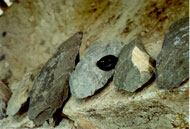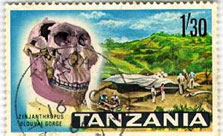 Anthropology
312, Lower Palaeolithic Prehistory
Anthropology
312, Lower Palaeolithic Prehistory Anthropology
312, Lower Palaeolithic Prehistory
Anthropology
312, Lower Palaeolithic Prehistory
Offered next in Winter term 2015 at 9:00 to 9:50
 |
 |
 |
(From left to right: Handaxes from Isimila, Tanzania; Zinjanthropus (Paranthropus) boisei and Olduvai Gorge; hippopotamus butchery at Koobi Fora, Lake Turkana, northern Kenya
 Course
description
Course
description
This course deals with the archaeology of human origins: the recovery and analysis of the earliest evidence for human cultural behaviour which belong to the Oldowan and Acheulean industries. The first part of the course will review major sequences of cultural development in the Old World from the beginnings of flaked stone tools around 2.5 million years ago until the appearance of new regional artifact traditions around 200,000 years ago. The second part will examine the methodology of Lower Palaeolithic research, and will directly address questions of what is known or can be learned about the identification of ancient archaeological sites, how early hominins made a living (hunting versus scavenging or gathering), settlement patterns, social behaviour, use of tools and evolution of technology, and so on. The implications of these ideas for models of human evolution will also be considered. Prerequisite: Anthropology 206 or consent of department.
Course requirements: Midterm exam 20%, term paper 30%, 2 critical summaries of articles in bibliography 20%, final exam 30%.
Text: A list of required readings will be available through E-class.
Course bibliography: Available through the E-class site.
 Related
general websites
Related
general websites
American Anthropological Association website.
American Museum of Natural History web site. The Anne and Bernard Spitzer Hall of Human Origins opened in 2007.
Archaeology Information. Information about archaeology, human evolution, human origins and hominid images.
Becoming Human. Human evolution website sponsored by Donald Johanson and the Institute for Human Origins.
Becoming Human. A 3- part Nova (PBS) series on human evolution, aired first in November 2009.
Center for Human Evolutionary Studies at Rutgers University.
Darwin. Web site to go with the American Museum of Natural History's exhibition on Darwin and evolution, November 2005.
Darwin Online. The complete works of Charles Darwin, for the bicentennial of his birth (2009).
Evolution. On line version of PBS series on the evolution of life, first broadcast on September 24-27, 2001.
Human origins and evolution in Africa. Dr. Jeanne Sept's website at Indiana University. Lots of good information about African prehistory, human evolution.
Human Origins Program, Smithsonian Institution, "What does it mean to be human?", Washington, D.C.
The Human Spark - a three part series about modern human origins on PBS in January 2010.
Institute for Human Origins. Located at Arizona State University.
L. S. B. Leakey Foundation for research on human origins.
National Museums of Kenya homepage.
Origins. PBS series about the origins of the earth and life. Broadcast September 2004.
Origins Net. "Three Million Years of Prehistoric Art, Religion and Symbol in Human Evolution".
Paleoanthropology Society. For study of human evolution. Also free access to their online journal, Paleoanthropology.
University of California at Berkeley Museum of Palaeontology. Good information on the geological time scale, systematics and evolution.
The Stone Age Institute at Indiana University.
Walking with cavemen. Website connected to BBC show on human evolution, broadcast in 2003. Also Nature - prehistoric life.
William Calvin's web site. Deals with his ideas on Quaternary climate change, human evolution, evolution of the brain and intelligence.
First words. E. Culotta and B. Hanson. The introduction to a special issue of Science on the evolution of language, February 27, 2004.
![]() Great
ape material culture. What does it tell us about the origins of human culture?
Great
ape material culture. What does it tell us about the origins of human culture?
Chimpanzee cultures. Material culture and behavior of chimpanzees.
Wild chimps rocked on: apes left unique record of stone tools. Science News March 30, 2002.
Excavation of a chimpanzee stone tool site in the African rainforest by J. Mercader et al. Science 296(5572): 1452-1455, May 24, 2002.
Smart chimps get their reward, BBC.
Orangutan cultures and the evolution of material culture by C. P. Van Schaik et al. Science 299(5603): 102-105, January 3, 2003.
 Lower
Palaeolithic archaeological and hominin fossil sites
Lower
Palaeolithic archaeological and hominin fossil sites
AFRICA
Website for the Human Evolution Research Center at the University of California, Berkeley. With interactive timeline for the Middle Awash research project.
Encore Olduvai. P. Tobias. Science 299(5610): 1193-1194, February 28, 2003.
Late Pliocene Homo and hominid land use from Western Olduvai Gorge, Tanzania. R. Blumenschine et al. Science 299(5610): 1217-1220, February 28, 2003.
Cradle of Humankind World Heritage Site early hominid sites in South Africa.
MIDDLE EAST
Were "little people" the first to venture out of Africa?. By M. Balter and A. Gibbons. Science, July 5, 2002.
A new skull of early Homo from Dmanisi, Georgia. A. Vekua et al. Science, July 5, 2002.
Pictures and description of new hominid from Dmanisi, Georgia. National Geographic, linked to August 2002 issue.
Stranger in a new land. Scientific American, November 2003. About Dmanisi.
Pleistocene milestones on the out-of-Africa corridor at Gesher Benot Ya'aqov, Israel. By N. Goren-Inbar et al. Science 289(5481): 944-947, August 11, 2000.
Evidence of hominin control of fire at Gesher Benot Ya'acov, Israel. By N. Goren-Inbar et al. Science 304(5671): 725-727, April 29, 2004. With news story "Earliest signs of human-controlled fire uncovered in Israel" by M. Balter.
EUROPE
Old Stone Age website. For study of the Palaeolithic. Research done by Harold Dibble and Shannon MacPherron.
Ancient human occupation of Britain project.
Sierra de Atapuerca. One of the most important early sites in Europe. This Spanish site has a number of localities including (a) the Gran Dolina, estimated to be around 800,000 years old, and (b) the Sima de los Huesos or "Pit of bones" which is between 200,000 and 300,000 years old. Together they have yielded a phenomenal number of hominid remains.
Disaster may have killed ancients. About the Sima de los Huesos people. BBC News, May 18, 2004.
New road reveals Stone Age site (Acheulean site in Wiltshire, England). BBC News, October 7, 2003.
Early human marks are 'symbols'. An engraved bone from Kozarnika cave, northwest Bulgaria. BBC News, March 16, 2004.
EAST AND SOUTHEAST ASIA
Homo erectus calvarium from the Pleistocene in Java, by H. Baba et al. Science 299(5611): 1384-1389, February 28, 2003.
Peter Brown's Australian and Asian palaeoanthropology page. Australian and East Asian hominid pictures and descriptions.
 Lower
Palaeolithic news
Lower
Palaeolithic news
Paleolithic technology and human evolution. Review article by Stan Ambrose. Science 291(5509): 1748-1753, March 2, 2001.
Killer cats hunted human ancestors. National Geographic news.
Bones hint at first use of fire. About Swartkrans, South Africa. BBC News, March 22, 2004.
 Dating
methods
Dating
methods
Berkeley Geochronology Centre. Information on dating methods for Palaeolithic and hominid sites.
Web sites for Professor Jack Rink of McMaster University, a specialist in dating Middle and Upper Pleistocene sites.
Magnetic storm. PBS show on changes in the earth's magnetic field. Reviews palaeomagnetism and the evidence that another magnetic polarity reversal is due to take place.
 General
science journals, which publish occasional articles on human biological or cultural
evolution:
General
science journals, which publish occasional articles on human biological or cultural
evolution:
American Scientist. Journal of Sigma Xi, the Scientific Research Society.
Nature. British science journal; also has link to the journal Nature Genetics. A place where initial palaeoanthropological discoveries are often reported.
Proceedings of the National Academy of Sciences.
Science. American science journal, similar to Nature.
Scientific American. Monthly.
 Other
journals or sources on human evolution and/or the Palaeolithic
Other
journals or sources on human evolution and/or the Palaeolithic
African Archaeological Review. Papers on African prehistory. Find through University of Alberta e-journals list.
Antiquity. British general archaeological journal; world coverage.
Archaeology. Popular archaeology magazine; published by Archaeological Institute of America.
Cambridge Archaeological Journal. Follow links to journal. Many papers on the beginnings of symbolic behaviour and the Middle/Upper Palaeolithic transition.
Current Anthropology. Articles with CA comment by other specialists. Many papers on Palaeolithic topics.
Evolutionary Anthropology. Good general articles on all aspects of human evolution.
Geoarchaeology. Articles on palaeoenvironments, geology and archaeology.
Journal of Anthropological Research. Articles on all aspects of anthropology, occasional ones on palaeoanthropology. Edited by Lawrence Straus, a Palaeolithic archaeologist.
Journal of Anthropological Archaeology. Available from Science Direct through the University of Alberta e-journals list
Journal of Archaeological Method and Theory.
Journal of Archaeological Science. Archaeometry papers. Available from Science Direct through the University of Alberta e-journals list
Journal of Human Evolution. Articles on all aspects of human evolution. Available from Science Direct through the University of Alberta e-journals list
Journal of World Prehistory. Review papers summarizing culture history for specific regions. Find through University of Alberta e-journals list.
Oxford Journal of Archaeology. Find through University of Alberta e-journals list.
World Archaeology. Each issue on a single theme. Find through University of Alberta e-journals list.
 Quaternary
environments and human prehistory
Quaternary
environments and human prehistory
Cracking the ice age. PBS Nova.
Cycles, cycles everywhere. Review of evidence for Milankovitch glacial cycling. Enhanced web site by T. J. Crowley published in Science 295(5559): 1473-1474, February 22, 2002.
EPICA adventure. Nature stories about the EPICA (European Project for Ice Coring in Antarctica) 740,000+ year ice core, June 10, 2004.
Quaternary refugia and persistence of biodiversity. Enhanced website by P. Taberlet and R. Cheddadi, published by Science, September 20, 2002.
International Geosphere-Biosphere Core project on past global changes (PAGES).
International Quaternary Association (INQUA).
Journal of Quaternary Science.
Palaeogeography, Palaeoclimatology, Palaeoecology. Past environmental information, from all periods, including the Quaternary.
Quaternary Environment Network. Information on environments of last 2 million years. Each continent is illustrated with maps from key periods; lots of documentation about evidence for palaeoenvironmental reconstruction.
Quaternary International. Each issue on a separate topic. January 2001: "Out of Africa in the Pleistocene".
Quaternary Research. Palaeoenvironments, palaeontology and archaeology of last 2 million years. Available from Science Direct through the University of Alberta e-journals list.
Quaternary Research Association.
Quaternary Science Reviews. Research papers on Quaternary environments, geology and archaeology.
QUEEN. Quaternary Environments of the Eurasian North.
Intergovernmental panel on climate change. Modern evidence for climatic change and what it may tell us about the past.

Go to top.
Click here to go back to Pam Willoughby's home page.